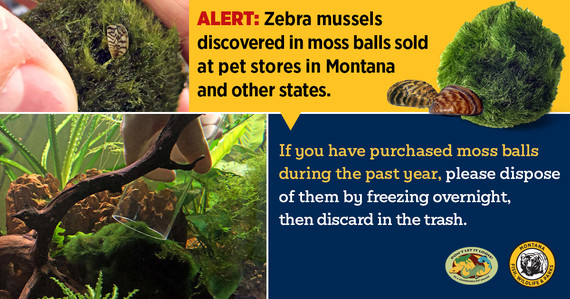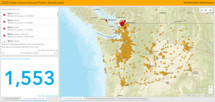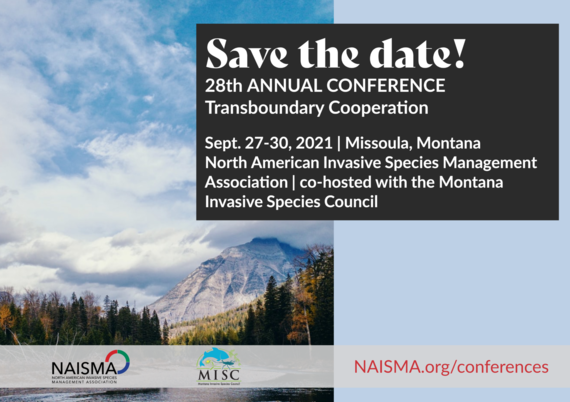|
The Invasive Species Bulletin provides you with all the latest news on invasive species in Montana and the region. Please let us know if you have any suggestions, contributions, questions, corrections, or comments. Email: scriswell@mt.gov
 Destroy! Don’t Dump! – Zebra Mussel Alert
Invasive zebra mussels have been found in "moss balls,” an aquarium plant product sold at aquarium and pet supply stores. Zebra mussels are regarded as one of the most destructive invasive species in North America. Zebra mussels can quickly take over once they get established in a waterbody and cause significant damage including disrupting the food chain, changing the chemistry of the water (which can cause more blue green algae outbreaks or offensive taste), and clogging water intake and delivery systems. The concern is that live mussels released into a storm drain or flushed could be introduced into a waterway.
For more information and instruction on how to dispose and report moss balls with zebra mussels, please visit: https://www.fws.gov/fisheries/ANS/zebra-mussel-disposal.html [lnks.gd]

Mangold given outstanding extension award
MISC member, Montana State University professor and MSU Extension specialist was recognized with a national award by the Weed Science Society of America for her excellence in outreach. Read more.
|
Call for Abstracts: Oral and Poster Presentations
2021 NAISMA ANNUAL CONFERENCE
September 27-30, 2021
Abstracts for the conference are due April 30 by 11:59 p.m. CT.
The 2021 North American Invasive Species Management Association Conference Co-hosted with the Montana Invasive Species Council will be broad in geographic scope, covering challenges and successes that impact and can influence all of North America including aquatic and terrestrial plants, animals, insects, pests, and pathogens.
The conference’s purpose is to improve management, prevention, control and mitigation of invasive species. It is geared toward a broad audience to foster connecting science, policy, management, and outreach efforts. Attendees will include land managers, agriculture and natural resource professionals, researchers, students, foresters, environmental consultants, private landowners, conservation group leaders, and non-governmental organizations.
If you are interested in proposing a special session, please contact mbodde@naisma.org to discuss. If approved, session organizers will be given specific abstract submission guidelines for presenters.
All prospective presenters (including regular and special sessions) must submit abstracts by the abstract deadline.
Call for MISC's next Science Advisory Panel Topic
MISC's Scientific Advisory Panel assembles MISC members, scientists, researchers, natural resource managers, and other experts who provide independent scientific advice to MISC on a wide-range of issues related to invasive species management in Montana.
MISC just wrapped up its latest panel on the Eastern heath snail. If you have an invasive species related scientific question or topic that needs investigation, submit your idea to scriswell@mt.gov. For more information about previous panels, visit https://invasivespecies.mt.gov/misc/Science-Advisory-Panel.
Citizen Science Data Critical to Fighting the Asian Giant Hornet
The Washington State Department of Agriculture created an Asian Giant Hornet Public Dashboard to share detection and trapping data...read more
|
|
 |
|
Don't Move Firewood New Feature Alert!
The Don’t Move Firewood website now features a geo-location tool, which pinpoints the location of a website visitor and encourages them to visit the appropriate Firewood Map page. This feature was designed to help website visitors that are looking for state or province specific information find it faster and more efficiently. Try going to DontMoveFirewood.org and see if the top of the page says "Start your adventure from (your state)!"
*if their privacy, browser, and device settings allow- otherwise it displays a location neutral message and links to the continent wide map view
Work.Clean.Go.
Do you manage land used by field workers, construction or industry? The PlayCleanGo brand has a sister identity called WorkCleanGo. This program was developed to remind those working on public and private land to clean their equipment and take precautions to prevent the spread of invasive species. Check out decals and posters to keep this messaging top of mind for your crew!
|
More news:
Limiting invasive species may be a better goal than eliminating them
Science Daily | March 4, 2021
30 Years Later: Mussel invasion legacy reaches far beyond Great Lakes
Great Lakes Now | Feb. 2, 2021
Tiny bubbles saving Lake Tahoe from invasive weeds
Tahoe Daily Tribune | Feb. 14, 2021
Events
March 31-April 1, EDDMapS Summit, virtual
April 6-8, Northwest Climate Conference, virtual
April 7, Western Regional Panel (WRP) Mid-Year Meeting, virtual
April 27-29, Planning for a Changing Climate – Putting Principles into Practice, virtual
May 15-22, National Invasive Species Awareness Week - Outreach & Education
May 18-20, North American Invasive Species Forum, Montreal, Quebec
June 2, MISC meeting, virtual
June 5-12, PlayCleanGo Awareness Week
September, Western Regional Panel, details to come
Sept- 27-30, North American Invasive Species Management Association Conference co-hosted with MISC, Missoula
 Publications
Spear, M. J., Walsh, J. R., Ricciardi, A., & Zanden, M. (2021). The Invasion Ecology of Sleeper Populations: Prevalence, Persistence, and Abrupt Shifts. BioScience.
Abstract: It is well established that nonnative species are a key driver of global environmental change, but much less is known about the underlying drivers of nonnative species outbreaks themselves. In the present article, we explore the concept and implications of nonnative sleeper populations in invasion dynamics. Such populations persist at low abundance for years or even decades—a period during which they often go undetected and have negligible impact—until they are triggered by an environmental factor to become highly abundant and disruptive. Population irruptions are commonly misinterpreted as a recent arrival of the nonnative species, but sleeper populations belie a more complex history of inconspicuous occurrence followed by an abrupt shift in abundance and ecological impact. In the present article, we identify mechanisms that can trigger their irruption, and the implications for invasive species risk assessment and management.
Learn about the impacts of community-based conservation, the types of work the Montana Watershed Coordination Council conservation partners are accomplishing on the ground, and how MWCC supports this work through the Watershed Fund and other services.
Science is driving technology innovation at an increasingly rapid rate, with genetic and digital technologies poised to potentially transform our National Biosecurity System – including the way we manage established invasive species. Our Centre commissioned this report to provide an overview of these and other technology opportunities, in order to inform the technology pathway that could be pursued through to 2030 and beyond.
Webinars
MSU Extension Service Weedy Wednesday Webinar (W3) Series
This webinar series is co-sponsored with Montana Weed Control Association. Webinars will take place via Webex on Wednesdays from 1-2 pm through the end of March, 2021. There is no cost to attend, but registration is required for each webinar. Webinars that qualify for 1 pesticide applicator credit are indicated with an asterisk (*).
Registration is separate for each webinar. Check back frequently for new links and available applicator credits (Montana only). Registration Information.
Non-native Invasive Earthworms 101: From the Nightcrawler to the Jumping Worm
-
March 17, 1 p.m. CT. Register here.
- Presented by: Ryan Hueffmeier, Director of the Boulder Lake ELC at the University of Minnesota
Online Forest Health Updates: Invasive species and new technologies
Cohosted Clemson and University of Florida
This free online training session will include presentations on: Invasive pests impacting forests and trees - Dr. Dave Coyle, Clemson University; Diseases impacting forests and trees - Dr. Ellen Crocker, University of Kentucky; Invasive plants - Chris Evans, University of Illinois; Technology for diagnostics and management - Dr. Dave Coyle and Dr. Ellen Crocker.
Monday, March 29, 2021 9:00 AM – 1:00 PM ET
Register via Eventbrite
Western State AIS - Watercraft Inspection and Decontamination Training (WIT II)
Virtual Training April 20-22. More Info/Register.
The training includes:
Introduction and Western State AIS Programs
Biology (Zebra/Quagga mussel and other Aquatic Invasive Species)
Watercraft 101
Inspection Procedures and practice
Triggers for decontamination and Step-by-step procedures.
Student Manual
Contact Info: (702) 236-3814 or quaggadee@cox.net
Emerald Ash Borer Deregulation and Programs Going Forward
Hosted by NAISMA
April 21, 2:00-3:00 PM ET Register on NAISMA site
PlayCleanGo Awareness Week & How to Integrate PlayCleanGo Outreach Tools
May 5, 1:00 PM CT Register on NAISMA site
Tree Health Monitoring for Invasive Pests
June 16, 2021, 1:00 PM CT Register on NAISMA site
Webinar Recordings
Western Governors Association Invasive Species Data Mobilization Campaign
The IMP Hour monthly online seminars
USACE: Invasive Watermilfoil Management - Nov. 12
Columbia Basin CWMA - Nov. 12
USACE: Flowering Rush - Nov. 4
Purchase access to the 2020 NAISMA Virtual Conference. $75
Request for Proposals-Assessing Aquatic Nuisance Species Outreach Effectiveness for Behavior Change
The Invasive Species Action Network (ISAN), in collaboration with the Western Regional Panel on Aquatic Nuisance Species (ANS) Education and Outreach Committee, is seeking proposals for a research assessment of the effectiveness of western states’ ANS outreach campaign messaging and delivery methods for eliciting prevention behavior change. The goal of this study is to take a west-wide approach to evaluating the effectiveness of AIS public awareness campaign messaging and delivery methods used at state and local agency levels and the study will complement a similar assessment of federal campaigns planned by the ANS Task Force. This project addresses a priority need identified in the Quagga Zebra Mussel Action Plan and will provide insights and recommendations to aid in enhancing ANS outreach efforts to maximize effectiveness at a west-wide scale. The funding period will be approximately one year with maximum funding available under this grant offering in the amount of $80,000. Proposal packages and questions should be submitted to Monica McGarrity, committee chair, at monica.mcgarrity@tpwd.texas.gov
Proposal submission deadline is March 31, 2021.
For more information, see the Request for Proposals at: https://westernregionalpanel.org/education-and-outreach-committee
Watershed Fund Project Support Funding Available
The MWCC Watershed Fund has grants available to assist community-based partners with implementing conservation projects on private land and supporting Natural Resources Conservation Service (NRCS) priorities in local watersheds. A total of $86,000 is available, with individual awards up to $20,000. A 1:1 non-federal match is required. Priority may be given to projects that support local NRCS Targeted Implementation Plans (TIPs); occur in collaboration with local NRCS offices; or address natural resource problems listed in local NRCS Long Range Plans (LRPs). TIPs and LRPs are listed by county on the NRCS Montana Focused Conservation Page.
Proposals are due by 5 pm on Friday, April 9, 2021. For more information, see the Request for Proposals. We also encourage you to contact Watershed Programs Coordinator Terri Nichols (terri@mtwatersheds.org) to discuss your project ideas.
|